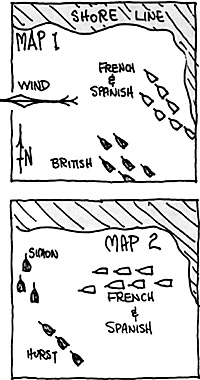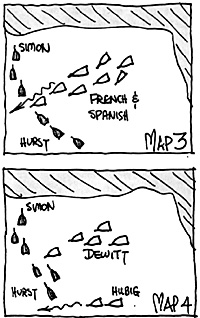 Brian Dewitt, of late, has been foisting on our group a series
of sailing ship battles using WOODEN SHIPS & IRON MEN (WSIM) rules.
I thought I had best speak out before this got out of hand. In his
latest foist, we had:
Brian Dewitt, of late, has been foisting on our group a series
of sailing ship battles using WOODEN SHIPS & IRON MEN (WSIM) rules.
I thought I had best speak out before this got out of hand. In his
latest foist, we had:
- 6 British ships 3 captained by W Simon, the Lion of the Sea,
and 3 by Bob Hurst. Five of the ships had "crack" crews, the other
an elite crew. None had enough guns.
5 French ships Captained by Fred Haub and B. Dewitt. These were big mommas, outgunning our British vessels, but with rotten crews.
2 Spanish ships Captained by Fred Hubig. More big mommas.
Map 1 shows the initial positions. Both sides had a favorable wind, blowing to the west, and the French/Spanish fleet's objective was to get to the western edge of the field, i.e., get out of the bay and into the open sea. The British mandate: stop 'em.
Captain Hurst and the Lion shot ahead of the enemy. and boxed the opposing ships in; Map 2 shows the manner in which the French and Spanish ships were cut off.
Having reached the position of Map 2, the Lion trod on the brakes, going dead in the water, and commenced to fire away at the oncoming ships.
The bold Captain of the Sea was resolved to go down with his ships rather than to let the opposition pass.
Each turn, the dead-in-the-water ships of the Lion drifted one inch to the west with the wind. At this rate, he would be cast ashore in the Bahamas in about 100 years or so, and to slow this rate of progress, the Lion threw out his anchors.
In truth, I'm not sure of the lingo... or to be more proper, the "parlance of the sea", so I can't really say if the Lion threw the anchors out, or threw them down, or threw them up, or threw them away, but they took hold, the Lion drifted no longer, and he actually got a "plus one" when firing.
 Map 3 indicates an attempted
breakout by one of the French
ships by dashing between the
Lion's ships and those of Captain
Hurst. The Frenchman never made
it... he was, in the vernacular of
the seafaring man, "blow'd up real
good".
Map 3 indicates an attempted
breakout by one of the French
ships by dashing between the
Lion's ships and those of Captain
Hurst. The Frenchman never made
it... he was, in the vernacular of
the seafaring man, "blow'd up real
good".
Map 4 shows how Captain Hubig's two Spanish vessels were attempting to make an end run to the south around the Hurst battle line.
By this time, three of the Frenchmen had been dismasted and served only as immobile firing platforms.
It appeared that El Capitan Hubig was going to make it! Santa Maria!
We never found out... Brian ended the game at this point.
The WSIM rules, as in all boardgame formats, used 6-sided dice. When firing, one would cross- reference the number of guns with the range to come up with a factor from around -2 to about +6.
To this factor was added a plus (or minus) for crew quality, for first-time broadside, and- several other items. The resultant gave the number of the "Fire Table" on each of which six possible results were tabulated. A 6-sided die roll chose the proper result.
Each Fire Table looked something like this:
| Die Roll | Rigging Hit | Hull Hit |
|---|---|---|
| 1 | 0 | 0 |
| 2 | R | H |
| 3 | R,C | H,C |
| 4 | R,C,H | 2H,R,G |
| 5 | 2R,C,G | 3H,2C |
| 6 | 3R,2C,G | 4H,C,3G,R |
R stands for rigging, C.for crew, H for hull, and G for guns.
There were about 12 of these charts (!), since there was a separate chart for each fire calculation result. I thought, at first, this was a rather primitive way to draw up fire table results, but after some cogitation, I realized that since there were four possible parameters (R,C,G,H) which might be affected on each hit, then perhaps a matrix of charts was the easy wayv out. Once the charts are drawn up, of course, they're there forever, and instead of four dice throws, one for each parameter, one die roll does it neatly.
The firing variations included firing with grapeshot or chainshot or roundshot or bullshot or whatever, beside firing at hull or rigging. Most of our British fire was aimed at the rigging... we first wanted to stop the opposition and then, sink 'em.
The tactic worked... the Brits stopped their opponents' lead ships, which then acted as stationary obstacles to be avoided by the remaining craft.
Although the fire tables prescribed hits on guns, crew, rigging and hull, one surprising omission was the lack of fires starting up on board. I was under the impression that, during a sea battle, fires would pop up all over the place - Errol Flynn and John Wayne are continuously fighting fires on their ships.
But the only place that WSIM included a fire was on the "critical hit" table. If, during the firing procedure, the die came up a 16% one would be directed to the "critical hit" chart.
Naval battles, to me, are dull enough, and I always look forward to a romp through the "critical hit" results. But, here, too, I was disappointed. Of some 30 "criticals" on the table, half were "No Effect" Only one entry referred to having a fire start up, and it didn't seem a very exciting fire at that.
I wanted not just a fire, but a CONFLAGRATION, a veritable FLAMING PYRE! And I didn't get it. Oh, well ...
One thing I should mention that deserves a plus: Brian's fleet was composed of Valiant Miniatures ships which were nicely. detailed and painted. I'm not sure of the scale, but the models were about three inches long, and looked quite good sailing on a blue cloth sea.
Back to PW Review July 1988 Table of Contents
Back to PW Review List of Issues
Back to MagWeb Master Magazine List
© Copyright 1988 Wally Simon
This article appears in MagWeb (Magazine Web) on the Internet World Wide Web.
Other articles from military history and related magazines are available at http://www.magweb.com